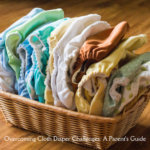Cloth diapering, once considered a relic of the past, has experienced a resurgence in recent years. As parents become more environmentally conscious and financially savvy, the use of cloth diapers has become increasingly popular. In this comprehensive guide, we’ll explore the myriad benefits of cloth diapering, compare them to disposable diapers, offer tips for choosing the best cloth diapers, and provide practical advice for washing and caring for them.
Pros of Cloth Diapering
One of the primary reasons parents opt for cloth diapers is their environmental sustainability. Unlike disposable diapers, which can take hundreds of years to decompose in landfills, cloth diapers are reusable and can significantly reduce waste. Additionally, cloth diapering can save families thousands of dollars over the diapering years, making them a cost-effective choice in the long run. Moreover, cloth diapers are free from the harmful chemicals found in many disposable diapers, providing a healthier and more comfortable option for babies’ sensitive skin.

Comparing Cloth Diapers vs Disposable Diapers
When weighing the decision between cloth and disposable diapers, several factors come into play. While cloth diapers have a higher initial cost, the savings over time can be substantial. Furthermore, cloth diapers have a significantly lower environmental impact, as they can be washed and reused multiple times. From a health perspective, cloth diapers are often preferred due to their lack of chemicals and reduced risk of diaper rash. However, disposable diapers offer unmatched convenience, particularly for busy parents on the go.

Choosing the Best Cloth Diapers for Your Baby
With a wide range of cloth diaper options available on the market, choosing the right one for your baby can feel overwhelming. From prefolds to all-in-ones, each type of diaper has its own set of pros and cons. Factors to consider include absorbency, fit, and ease of cleaning. Personal recommendations from experienced parents can also be invaluable in finding the perfect cloth diaper for your baby’s needs.
Tips for Washing Cloth Diapers
Proper care and maintenance are essential for prolonging the life of cloth diapers and keeping them clean and odor-free. Before using new diapers, it’s important to prep them according to manufacturer instructions. When it comes to washing, using a detergent free from additives and fragrances is key to preventing buildup and irritation. Dealing with stains and odors may require some trial and error, but with the right techniques, even the toughest stains can be removed.

Cloth Diapering for Specific Needs
Parents of babies with special needs, such as heavy wetters or sensitive skin, may face additional challenges when it comes to cloth diapering. Fortunately, there are solutions available to address these issues, from extra absorbent inserts to organic and natural fiber options. Preemies and newborns also have unique needs when it comes to diapering, including smaller sizes and extra care around the umbilical cord stump.
Navigating Cloth Diaper Brands
With so many cloth diaper brands on the market, it can be difficult to know where to start. Researching and comparing popular brands based on features, materials, and customer reviews can help narrow down the options. Additionally, seeking recommendations from other parents who have firsthand experience with different brands can provide valuable insights.
Practical Aspects of Cloth Diapering
Building a cloth diaper stash takes careful planning and consideration of your baby’s needs. Whether you choose to purchase new diapers or explore the secondhand market, it’s important to have enough diapers on hand to last between washes. Essential accessories such as wet bags, diaper pails, and liners can also streamline the cloth diapering process and make it more manageable.

Cloth Diapering On-the-Go
While cloth diapering at home may seem straightforward, doing so while traveling or out and about presents its own set of challenges. Packing the necessary supplies, finding suitable washing facilities, and managing dirty diapers on the go requires careful planning and preparation. Additionally, navigating daycare and babysitter arrangements can require open communication and flexibility.
Troubleshooting Common Issues
Despite their many benefits, cloth diapers are not without their challenges. Leaks, blowouts, and diaper rash are common issues that parents may encounter along the way. Fortunately, there are strategies for addressing these problems, from adjusting the fit of the diapers to using diaper creams and liners. By troubleshooting common issues as they arise, parents can ensure a positive cloth diapering experience for both themselves and their baby.







